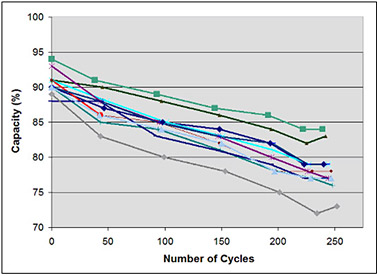Have a battery powered string trimmer (Ryobi 40V) with 3Ah battery. Recently noticed the battery didn't last very long so charged the battery and put it on a constant current load device at work. 1A load. It ran about 2.5 hours before the internal circuit detected it was at the low limit (about 30v) and cut off the output (the battery has a circuit board with some electronics on it that others have detailed on the web). Anyway - so fairly close to the 3Ah rating. In actual use it runs out of charge in about 30 minutes. I wonder if the internal resistance is going up so at higher load the losses are greater and thus the short run time. I don't have any quantitative numbers for capacity or run time from when it was new (about 1.5 years ago) but just observed it was short lately.
For comparison I just got a blower with the same type battery but 4Ah. Running the same trimmer it ran for about 1.5 hours and still had about 1 bar of charge (1/4?) remaining. Planning to do a similar load test on it tomorrow.
Going to try to get a warranty replacement as it still has a few months left on the warranty but wondering if they will reject it because it still does charge and have partial capacity. See lots of reports on line of other issues such as the charger refusing to charge the battery giving a red light that definitely shows a bad battery and mine is not giving that obvious of indication.
Also wondering what is the appropriate discharge rate for testing. For some batteries it is something like 1/10 or 1/20 of Ah (for example for 4 Ah battery use 0.4 A load which should last 10 hours) but for these I have found higher loads typically used.
For comparison I just got a blower with the same type battery but 4Ah. Running the same trimmer it ran for about 1.5 hours and still had about 1 bar of charge (1/4?) remaining. Planning to do a similar load test on it tomorrow.
Going to try to get a warranty replacement as it still has a few months left on the warranty but wondering if they will reject it because it still does charge and have partial capacity. See lots of reports on line of other issues such as the charger refusing to charge the battery giving a red light that definitely shows a bad battery and mine is not giving that obvious of indication.
Also wondering what is the appropriate discharge rate for testing. For some batteries it is something like 1/10 or 1/20 of Ah (for example for 4 Ah battery use 0.4 A load which should last 10 hours) but for these I have found higher loads typically used.

